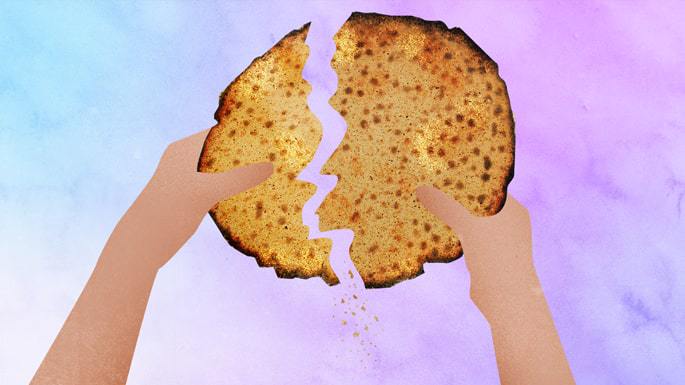After we make kiddush and eat the vegetable dipped in salt water at the Passover Seder, we crack the middle matzah. We set aside the bigger half for the afikoman and return the smaller piece to our Seder plate to be eaten after we make the blessing over the matzah.
However, the purpose of breaking the matzah is not to produce a piece to hide for the afikoman.
On the contrary, the afikoman is simply a side benefit of breaking the matzah, giving us an additional mitzvah from the same matzah.1
So why do we break the matzah? It is so there be broken bread on the table when we say the Haggadah.
This is because scripture refers to the matzah as lechem oni. This term is understood as “poor man’s bread.” Thus, the sages teach us that when we say the blessing over the matzah, we must have a broken matzah (in addition to a full matzah), as poor folk often just have scraps or make sure to leave leftovers for the coming meal.
The sages also interpret lechem oni as “bread of answering.” Thus, we must say the Haggadah (“answer”) over broken matzah (“afflicted bread”).2
From Poor to Rich
Of course, there are deeper reasons as well.
The Rebbe3 explains that the splitting of the matzah reflects the essential theme of the Passover Seder.
At first glance, there seems to be a dichotomy between what we use the two halves of this matzah for. The smaller half represents the poor man's bread, which is, well, poor. And the larger half becomes the afikoman, which represents our freedom and affluence after the Exodus, as well as our faith that we will once again celebrate Passover with the Paschal lamb in the Holy Temple.
Yet we specifically put the poor man’s bread back onto the Seder plate when we celebrate our freedom, while the freedom-themed half is hidden.
It’s also striking that these opposing pieces of matzah come from a single loaf.
In truth, we find both opposing concepts reflected in the general reasons for eating matzah on Passover.
On the one hand, it is the bread of affliction, recalling the suffering in Egypt. Yet, on the other hand, the Torah also tells us that it recalls how the Exodus came so quickly that “there wasn’t even time for their bread to become leaven.”
The Rebbe explains that this is precisely the point. As the verse states, “ From the straits I called G‑d; G‑d answered me with a vast expanse.”4 It is specifically from constraints, darkness and tragedies of exile that we come to the “vast expanse” of the Redemption.
This teaches us an important lesson.
One should not look at the darkness of exile despairingly, thinking that it is impossible that we can in one moment go to the other extreme, to an era of redemption and light. On the contrary, one flows from the other—it is “one matzah.” It’s from these constraints that we are able to get to the final Redemption.
However, the redemption aspect is still hidden from us, so we hide the piece of matzah for the afikoman. Yet, knowing that Redemption is already here, albeit hidden, gives us strength to overcome the harshness of exile and reach our end goal.
May it be speedily in our days!







Join the Discussion